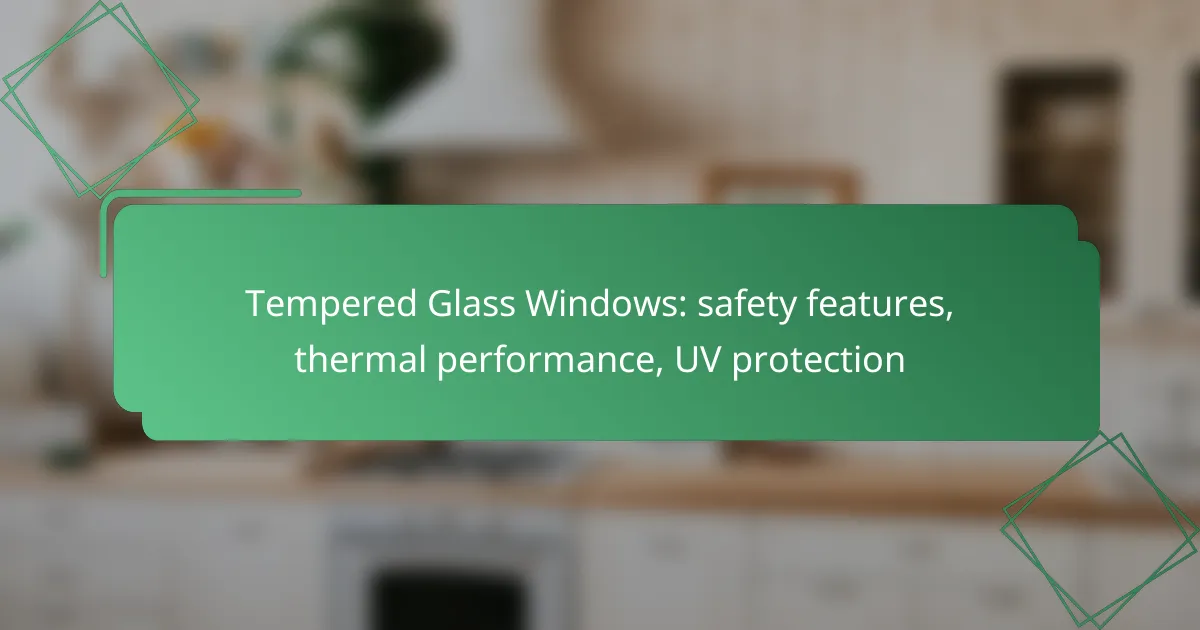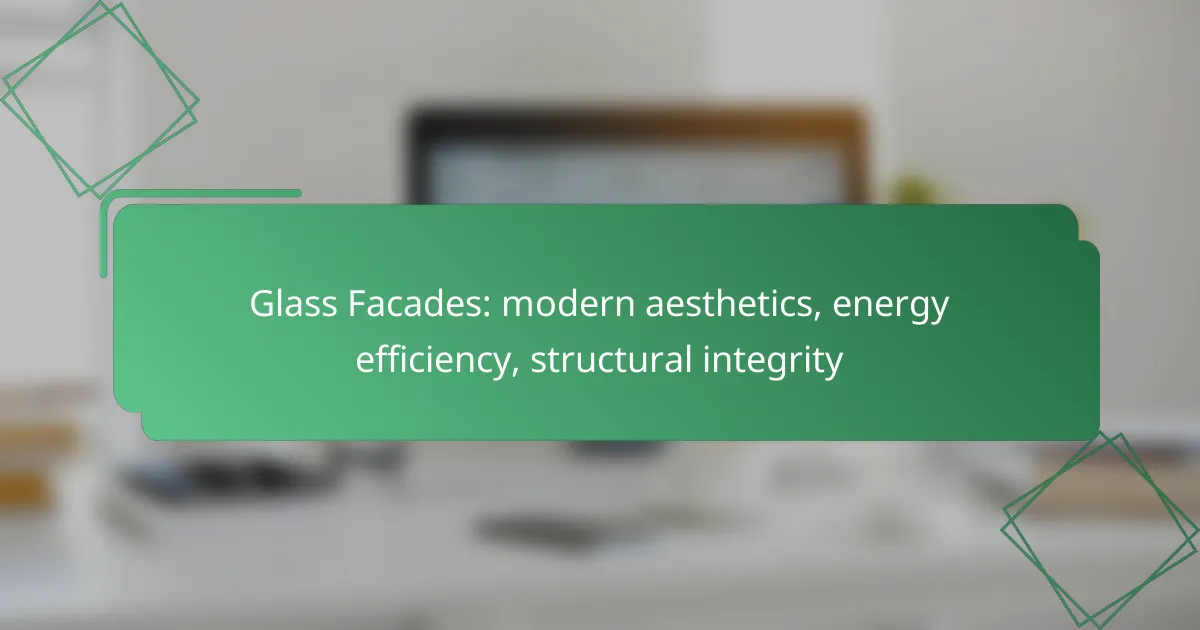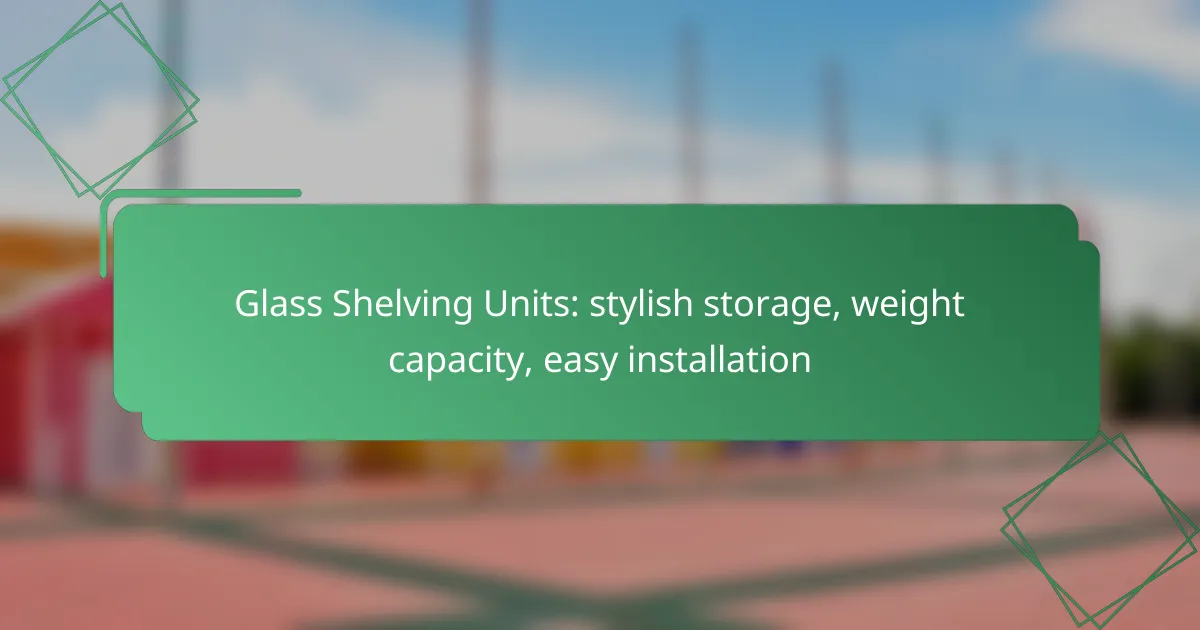Tempered glass windows are engineered with advanced safety features that enhance their strength and resistance to breakage, making them a reliable choice for various applications. In addition to their durability, these windows offer superior thermal performance, improving energy efficiency by minimizing heat transfer. Furthermore, they provide significant UV protection, effectively blocking harmful rays that can fade furnishings and pose health risks to occupants.

What are the safety features of tempered glass windows?
Tempered glass windows are designed with several safety features that enhance their durability and resistance to breakage. These features make them a popular choice for both residential and commercial applications, providing peace of mind for property owners.
Impact resistance
Tempered glass is significantly more resistant to impact compared to standard glass. This is due to the heating and rapid cooling process it undergoes, which strengthens the material. As a result, tempered glass can withstand high levels of force, making it ideal for areas prone to accidental impacts, such as doors and low windows.
In practical terms, tempered glass can resist impacts from objects like hail or thrown debris, reducing the risk of shattering. This quality is particularly beneficial in regions with severe weather conditions.
Shatter-proof design
The shatter-proof design of tempered glass ensures that if it does break, it fractures into small, blunt pieces rather than sharp shards. This minimizes the risk of injury from broken glass, making it a safer option for homes and businesses.
This feature is especially important in environments where safety is a priority, such as schools, hospitals, and playgrounds. Choosing tempered glass can help enhance safety in these settings.
Edge strength
Tempered glass has enhanced edge strength compared to regular glass, which is crucial for maintaining structural integrity. The edges are less likely to chip or break, which can compromise the entire pane. This strength is vital for installations where the edges are exposed or subject to stress.
When selecting tempered glass, consider the thickness and edge treatment options available, as these can further improve durability and performance in specific applications.
Safety certifications
Many tempered glass products come with safety certifications that verify their compliance with industry standards. Look for certifications such as ANSI Z97.1 or ASTM C1048, which indicate that the glass has undergone rigorous testing for safety and performance.
Choosing certified tempered glass not only ensures safety but may also be a requirement for building codes in certain areas. Always check local regulations to ensure compliance when selecting glass for construction or renovation projects.

How do tempered glass windows perform thermally?
Tempered glass windows offer excellent thermal performance, significantly improving energy efficiency in buildings. They help maintain indoor temperatures by reducing heat transfer, making them a popular choice for both residential and commercial applications.
Energy efficiency
Tempered glass windows enhance energy efficiency by minimizing heat loss during colder months and reducing heat gain in warmer months. This dual action can lead to lower heating and cooling costs, making them a cost-effective option over time.
In regions with extreme temperatures, using tempered glass can contribute to energy savings of around 20-30% compared to standard glass. This efficiency is particularly beneficial in climates with significant seasonal variations.
Insulation properties
The insulation properties of tempered glass are enhanced by its thickness and the manufacturing process, which creates a stronger and more durable product. These windows often feature low-emissivity (Low-E) coatings that further improve insulation by reflecting heat back into the room.
When selecting tempered glass windows, consider options with double or triple glazing for optimal insulation. These configurations can significantly decrease thermal bridging and improve overall window performance.
Heat resistance
Tempered glass is designed to withstand higher temperatures than standard glass, making it ideal for areas exposed to direct sunlight or heat sources. This heat resistance helps prevent thermal breakage, ensuring longevity and safety.
In practical terms, tempered glass can typically handle temperature fluctuations of up to 250°C without compromising its structural integrity. This makes it suitable for various applications, including skylights and patio doors, where heat exposure is common.
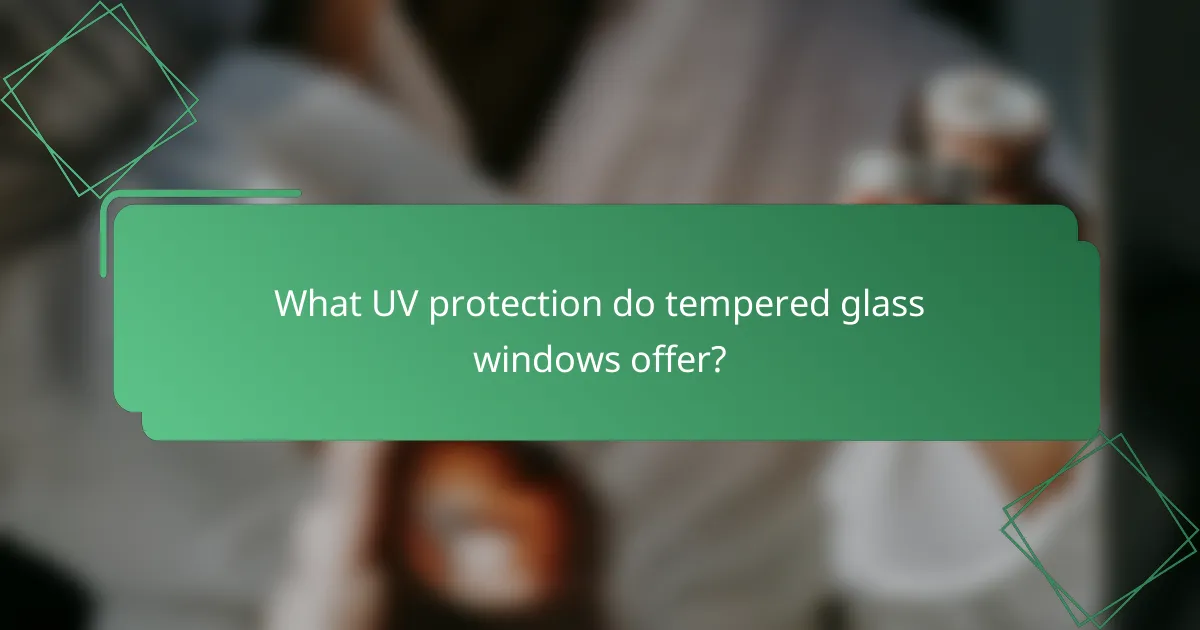
What UV protection do tempered glass windows offer?
Tempered glass windows provide significant UV protection by blocking a large percentage of harmful ultraviolet rays. This feature helps to reduce fading of interior furnishings and protects occupants from potential skin damage.
UV filtering capabilities
Tempered glass can filter out up to 99% of UV radiation, depending on the specific product and coatings used. This capability is crucial for maintaining the integrity of furniture, flooring, and artwork by minimizing sun damage over time.
When selecting tempered glass windows, consider options with additional UV-blocking coatings for enhanced protection. These coatings can further improve the glass’s ability to shield against UV rays while maintaining clarity and visibility.
Health benefits
The UV protection offered by tempered glass windows contributes to better health by reducing exposure to harmful rays that can lead to skin cancer and other health issues. By blocking these rays, occupants can enjoy natural light without the associated risks.
Additionally, using tempered glass can help create a more comfortable indoor environment. By limiting UV exposure, it reduces glare and helps maintain a stable temperature, which can be particularly beneficial in sunny climates.
Material composition
Tempered glass is made by heating standard glass to high temperatures and then rapidly cooling it, which increases its strength and durability. This process also enhances its UV filtering capabilities, making it a preferred choice for windows.
Some tempered glass products may include additional materials or coatings designed specifically for UV protection. When choosing tempered glass, look for certifications that indicate the level of UV protection and overall quality to ensure optimal performance.
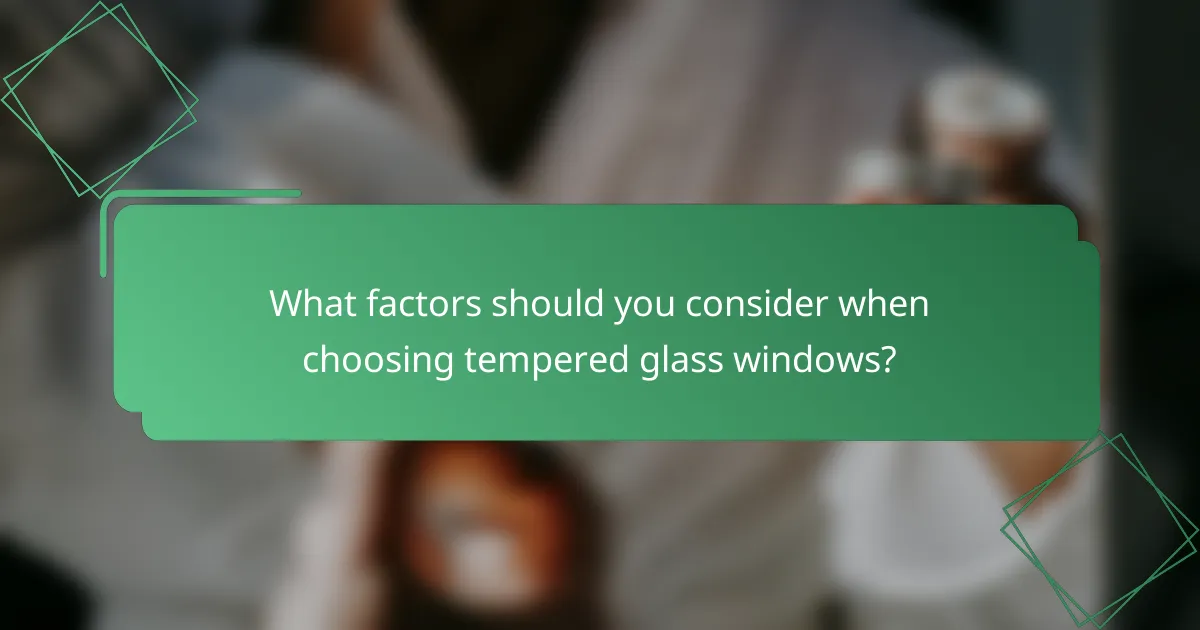
What factors should you consider when choosing tempered glass windows?
When selecting tempered glass windows, consider safety features, thermal performance, and UV protection. These factors will significantly influence the durability, energy efficiency, and comfort of your home.
Local climate considerations
Your local climate plays a crucial role in determining the type of tempered glass windows you should choose. In regions with extreme temperatures, look for windows with high thermal performance ratings to minimize heat loss in winter and heat gain in summer.
Additionally, if you live in an area prone to storms or high winds, opt for thicker tempered glass to enhance safety and structural integrity. This can help prevent shattering and improve overall resilience against harsh weather conditions.
Building codes in Canada
In Canada, building codes dictate specific requirements for tempered glass windows to ensure safety and energy efficiency. Familiarize yourself with the National Building Code of Canada (NBC), which outlines standards for glass thickness, installation, and performance ratings.
It’s essential to consult local regulations, as they may have additional requirements based on regional climate and safety concerns. Working with a certified contractor can help ensure compliance with these codes and optimize your window selection for your specific location.
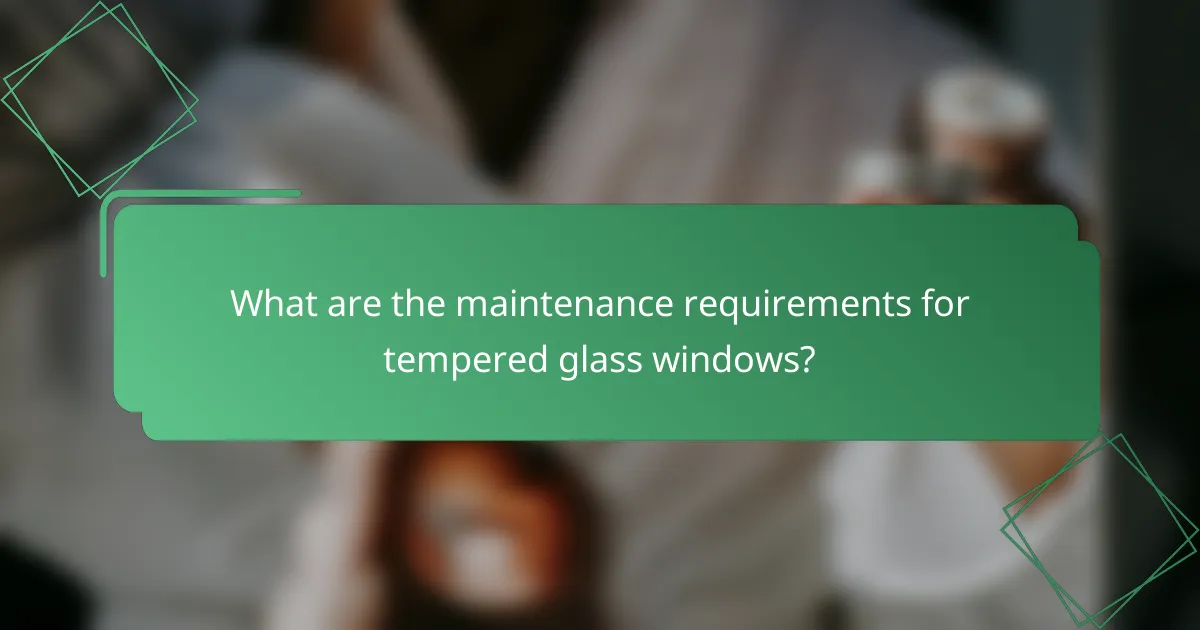
What are the maintenance requirements for tempered glass windows?
Tempered glass windows require minimal maintenance to ensure their safety and performance. Regular cleaning and periodic inspections are essential to maintain their clarity and structural integrity.
Cleaning methods
To clean tempered glass windows, use a soft cloth or sponge with a mild detergent mixed with water. Avoid abrasive cleaners or tools that could scratch the surface. For streak-free results, consider using a squeegee after washing.
For tough stains or residues, a mixture of vinegar and water can effectively break down grime without damaging the glass. Rinse thoroughly with clean water to prevent any residue from remaining.
Inspection frequency
Inspect tempered glass windows at least twice a year for any signs of damage, such as cracks or chips. Early detection of issues can prevent more significant problems and ensure safety.
In addition to regular inspections, check the seals and frames for signs of wear or deterioration. If you live in an area with extreme weather conditions, consider increasing the frequency of inspections to every three to four months.

What are the emerging trends in tempered glass technology?
Emerging trends in tempered glass technology focus on enhanced safety features, improved thermal performance, and increased UV protection. Innovations in manufacturing processes and coatings are driving these advancements, making tempered glass more versatile and efficient for various applications.
Safety features of tempered glass
Tempered glass is known for its strength and safety, as it is treated to withstand high stress and impact. When broken, it shatters into small, blunt pieces rather than sharp shards, reducing the risk of injury. Recent advancements include the integration of smart technology that can detect stress and alert users before breakage occurs.
Additionally, laminated tempered glass combines layers of glass with a plastic interlayer, enhancing safety further by holding the pieces together upon impact. This type of glass is increasingly used in high-traffic areas and buildings requiring stringent safety standards.
Thermal performance of tempered glass
Tempered glass offers excellent thermal performance, helping to regulate indoor temperatures and improve energy efficiency. It can withstand high temperatures without deforming, making it suitable for both residential and commercial applications. Low-emissivity (Low-E) coatings are becoming popular, as they reflect heat while allowing natural light to pass through.
When selecting tempered glass, consider factors such as the climate and building orientation. In colder regions, double-glazed tempered glass can significantly reduce heating costs, while in warmer climates, it can help maintain cooler indoor temperatures.
UV protection of tempered glass
Tempered glass provides a degree of UV protection, blocking a significant portion of harmful ultraviolet rays. This feature is crucial for preserving furniture, flooring, and artwork from fading due to sun exposure. Newer technologies are enhancing the UV-blocking capabilities of tempered glass, making it an attractive option for homes and businesses.
When choosing tempered glass for UV protection, look for products specifically designed with enhanced UV filtering properties. This can be particularly beneficial in sunny climates or for buildings with large glass facades that receive direct sunlight for extended periods.






